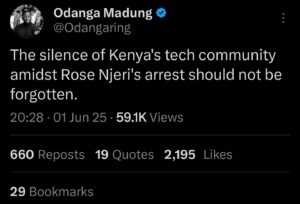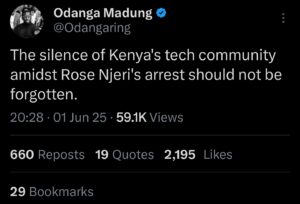Your Monday Reads: KICTANet in the News & Diverse Kenyan Media Landscape
The Communication Authority of Kenya has published the Kenya Media
Landscape Report for July-September 2023.
This report
<www.ca.go.ke/sites/default/files/2024-02/Audience%20Measurement%20and%20Industry%20Trends%20Report%20July-September%202023_0.pdf>
shows
a diverse media landscape in Kenya with variations in preference across
regions and demographics. While radio remains dominant in most areas,
internet usage is growing, and media consumption patterns are evolving.
*Kenya Media Landscape Highlights *
*Radio:*
– The highest listenership is in South Nyanza, followed by the Lake and
Rift Valley regions.
– Lowest listenership in the Eastern region.
– Swahili is the most common language, followed by vernacular languages.
– Western and Coast regions prefer Swahili stations.
– Lake and Lower Eastern regions prefer vernacular stations.
*Overall Media Consumption:*
– Radio and TV lead in all regions except North Eastern, where internet
usage is highest.
– Newspaper readership is highest in Nairobi and Western regions.
*Listenership Differences:*
– Five regions have close radio listenership rates, ranging from 81% to
85%.
– North Eastern region has the lowest radio listenership (54%) but the
highest internet usage (64%).
*Internet Usage:*
– Nairobi has the highest internet usage (75%).
– South Nyanza, with the highest radio listenership, has the lowest
internet usage (44%).
*Newspaper Readership:*
– More males read newspapers than females.
– Readership is similar across age groups.
– The highest readership is in Nairobi, Western, and urban areas.
*Media Advertising:*
– Television is the most popular advertising platform, receiving Sh10.9
billion from a total Sh16 billion budget.
– Radio received Sh3.6 billion, and print media received Sh1.6 billion.
*Media Growth:*
– Radio stations increased from 120 to 228 between 2015 and 2022.
– TV stations increased from 9 to 182 between 2015 and 2022.
– The increase in TV stations is attributed to the rise of digital media
and streaming options.
*1. KICTANet Tackles Digital IDs at the World Conference on Statelessness*
KICTANet is participating in the 2024 World Conference on Statelessness,
held in Kuala Lumpur, Malaysia. This event brings together individuals with
diverse experiences and expertise related to statelessness.
At the conference, KICTANet, part of the digital ID community, will host
two key sessions exploring the complex relationship between digital
identity systems, public infrastructure, and the consequences for stateless
individuals. You can read more about our participation here
<www.kictanet.or.ke/kictanet-tackles-digital-ids-at-the-2024-world-conference-on-statelessness/>
:
*2. First Public Gathering of New Digital ID & Human Rights Coalition:*
KICTANet is also a member of a new transnational civil society community
focused on digital ID and human rights. This community recently held its
first public gathering to discuss concerns with current systems and
emphasize the need for collaboration and human-centred design. You can
learn more about this new coalition and its goals here
<www.kictanet.or.ke/first-public-gathering-of-new-digital-id-and-human-rights-coalition/>
:
*3. eCitizen: A Glittering Promise Mired in Ownership, Payment, and
Adoption Issues:*
This is an article on the challenges faced by Kenya’s eCitizen platform, a
government portal providing online access to various services. The article
raises concerns about ownership wrangles, payment system issues, and
adoption challenges, highlighting the need for transparency and
user-centric improvements. You can find the full article here:
<www.kictanet.or.ke/ecitizen-a-glittering-promise-mired-in-ownership-payment-and-adoption-issues/>
Also, check out our
<www.linkedin.com/pulse/kictanets-top-notch-initiatives-you-wont-believe-whats-happening-xjhaf/?utm_source=share&utm_medium=member_android&utm_campaign=share_via>newsletter
for what you missed since the year began.




